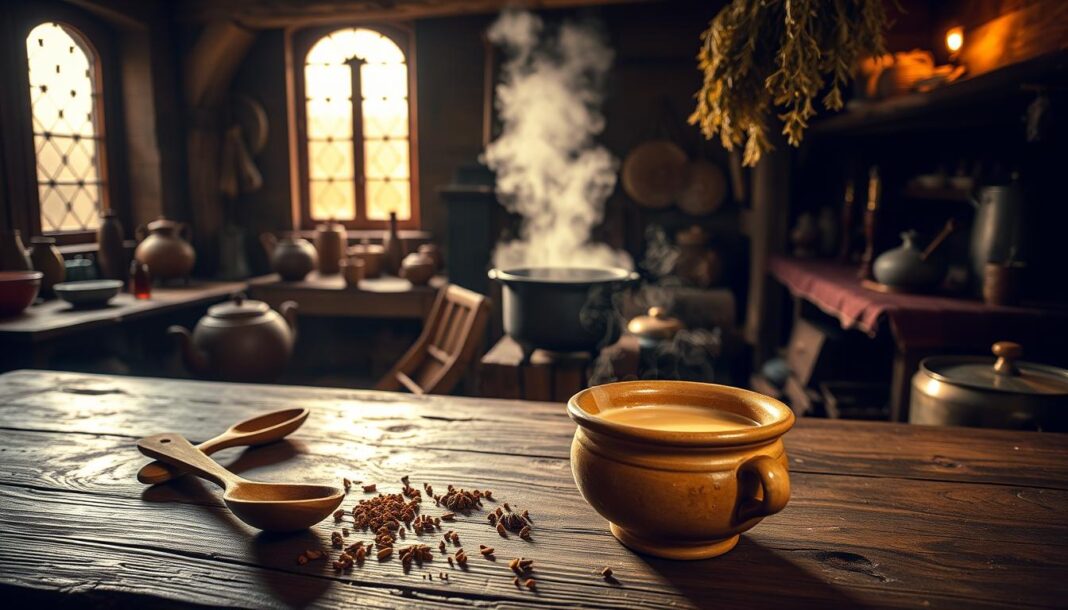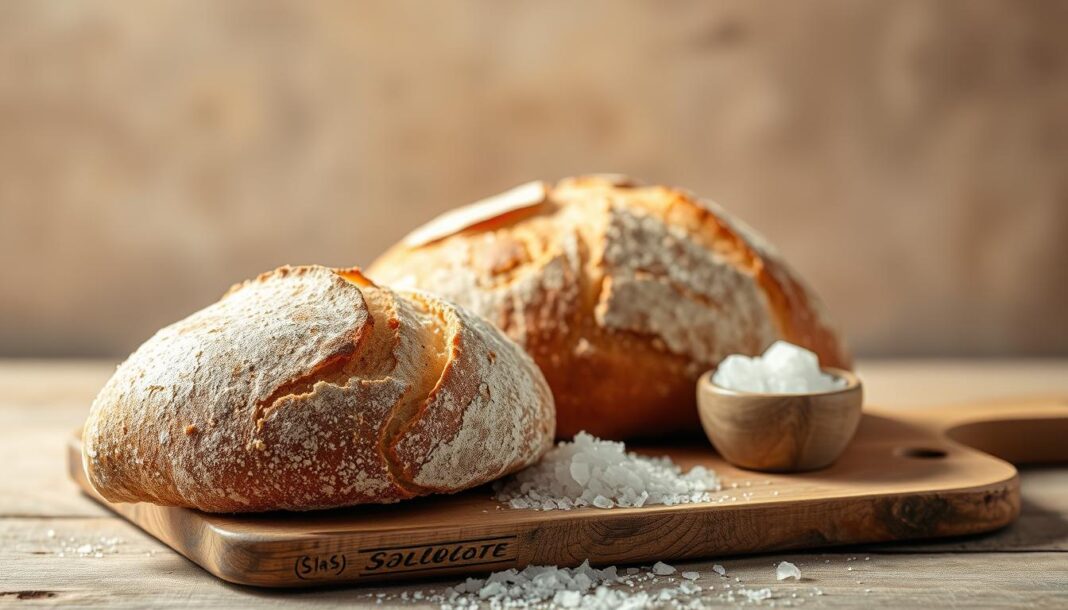As we explore the fascinating world of historical beverages, we come across caudle, a drink that has warmed generations across centuries. This medieval concoction has evolved over time, transforming from a medicinal tonic to a comforting beverage that continues to intrigue culinary historians today.
Our journey into the world of caudle reveals a rich history and a versatile recipe that can be made with ingredients you likely already have at home. By examining the evolution of this nourishing drink, we can appreciate its significance as a substantial meal in a cup.
Throughout this guide, we’ll walk you through our perfected caudle recipe and provide context on its historical significance, allowing you to experience a taste of history and understand why it deserves a place in contemporary cooking.
The Rich History of Caudle
As we explore the rich history of caudle, we uncover a tale of evolution and adaptation that spans centuries. Caudle, a drink that has been a part of European culinary tradition for centuries, has undergone significant transformations over the years.
Origins in Medieval Europe
Caudle’s origins can be traced back to medieval Europe, where it was initially prepared as a simple, nourishing beverage. The early versions were likely made with basic ingredients such as grains, water, and spices. The drink was valued for its warming and restorative properties, making it a staple in many households.
The medieval caudle was not just a drink; it was a symbol of hospitality and care. It was often served to the sick and the elderly, showcasing its role in medieval society beyond just being a meal accompaniment.
Medicinal and Ceremonial Uses
Caudle played a significant role in medieval and Renaissance Europe, not just as a food item but also for its medicinal and ceremonial uses. It was believed to have healing properties, making it a common drink during illnesses. Additionally, caudle was served during special occasions and ceremonies, highlighting its importance in cultural practices.
- It was used to comfort the sick and the grieving.
- Caudle was a part of various ceremonies, including childbirth and post-natal care.
- The drink’s nourishing properties made it a staple in monastic kitchens.
Evolution Through the Centuries
As the centuries rolled on, caudle adapted and evolved. During the Renaissance, it became more refined, with variations that included wine and spirits. The addition of alcohol gave rise to posh versions that graced the tables of nobility. 
In today’s culinary landscape, where ancient recipes are cherished and reimagined, caudle is experiencing a renaissance of its own. Chefs and home cooks are revisiting this timeless classic, infusing it with modern twists that maintain its comforting essence. The evolution of caudle reflects changing tastes, available ingredients, and cultural contexts across the centuries.
- By the 17th and 18th centuries, caudles had become more standardized, with recipes appearing in popular cookery books.
- The introduction of new ingredients from colonial trade routes led to innovative variations like tea caudles.
- Today, historical food enthusiasts and professional chefs are rediscovering these ancient recipes, bringing caudle back into contemporary kitchens.
Understanding the Traditional Caudle Recipe
Delving into the traditional caudle recipe, we uncover the rich history and regional variations that have shaped this beloved beverage. Traditionally, caudle was made with either strong white wine or ale, resulting in two distinct variations: white caudle and brown caudle, respectively.

Regional Variations
Regional variations played a significant role in shaping the caudle recipe. Different regions had their preferences for either white or brown caudle, influenced by local ingredients and cultural practices. For instance, in Scotland, heather ale like Fraoch was sometimes used to create a unique flavor profile, while wines from Scotland, such as Cairn O’Mhor, were preferred for white caudle.
Key Ingredients and Their Significance
The key ingredients in a traditional caudle recipe include egg yolks, which were used to thicken the mixture, along with spices and either wine or ale. The choice between white wine and ale not only affected the flavor but also the texture and the occasion on which it was served. The use of expensive spices and sometimes ground almonds in white caudles made them smoother and more appropriate for formal events or for those with delicate constitutions.
White vs. Brown Caudle
The distinction between white and brown caudle went beyond just the color; it reflected the social context and purpose of the drink. White caudles, made with white wine, were considered more refined and were often served at formal events. In contrast, brown caudles, made with ale, were heartier and more common in everyday households, serving as a meal replacement for working people. The preparation methods also differed, with white caudles requiring careful temperature control to prevent the wine from becoming too acidic when heated with egg yolks.
Our Tested Caudle Recipe
After uncovering the layers of caudle’s past, we’re excited to share our tested recipe, designed to bring this ancient beverage into your modern kitchen. This traditional drink, with its rich history, is now accessible to you through our carefully crafted instructions.
Ingredients List
To make our caudle, you’ll need the following ingredients:
- 2 cups of water
- 1 cup of milk
- 2 tablespoons of honey or sugar
- 1/4 teaspoon of ground ginger
- 1/4 teaspoon of ground cinnamon
- 2 eggs, beaten
- 1 tablespoon of whiskey or other liquor (optional)
These ingredients come together to create a comforting and flavorful drink, reminiscent of the caudles enjoyed in medieval times.
Equipment Needed
To prepare our caudle, you’ll need a few basic pieces of equipment:
- A medium saucepan
- A whisk or spoon for mixing
- A fine-mesh strainer
- Individual serving cups or mugs
Step-by-Step Preparation
Preparing the Base
Begin by combining the water, milk, honey or sugar, ginger, and cinnamon in a saucepan. Heat this mixture over medium heat, stirring occasionally, until it reaches a gentle simmer.
Adding Flavors and Thickening
Once the base is hot, gradually whisk in the beaten eggs to thicken the mixture. Continue to heat the caudle, stirring constantly, until it thickens to your liking. If using liquor, stir it in just before removing from heat.
Final Touches
Strain the caudle into individual serving cups to remove any egg solids. Serve immediately, as the caudle is best enjoyed hot.
Serving Suggestions
We recommend serving caudle immediately while it’s still hot. You can enjoy it on its own or poured over simple baked goods like bannocks or desserts. For an added touch, dust with freshly grated nutmeg or cinnamon.
- Serve in traditional small ceramic cups or modern mugs.
- Use as a sauce over bread pudding or plain cake for a historically inspired dessert.
- Garnish with a sprinkle of nutmeg or cinnamon for added visual appeal.
Modern Adaptations and Variations
By adapting the traditional caudle recipe, we can create versions that suit contemporary culinary preferences. This flexibility is a testament to the drink’s enduring appeal and its ability to evolve with changing tastes and dietary requirements.
Non-Alcoholic Version
For those who prefer a non-alcoholic version, we can substitute the white wine with a mixture of apple cider vinegar and water or simply omit it altogether, adjusting the amount of sugar to taste. This adaptation retains the drink’s warming and spicy characteristics without the alcohol content.
Vegan Caudle Alternative
A vegan version of caudle can be made by replacing egg yolks with a suitable alternative such as aquafaba or a commercial egg substitute. We can also use a plant-based milk to create a creamy texture, ensuring that the drink remains accessible to those following a vegan diet.
Spice Variations for Different Tastes
The spice blend in caudle can be adjusted to suit individual tastes. For example, adding a pinch of cinnamon or a few cloves can introduce a new layer of warmth, while a grated ginger can add a spicy kick. Experimenting with different spice combinations allows us to tailor the drink to our preferences.
Tea Caudle – An 18th Century Innovation
One of the most fascinating adaptations of caudle is the tea caudle, which emerged in the 18th century with the introduction of tea from China. This version combines strong green tea with egg yolks and white wine, creating a unique flavor profile that bridges Eastern and Western culinary traditions. As described in The Compleat Housewife by Eliza Smith (1736), “Make a quart of strong green Tea, and pour it out into a skillet, and set it over the fire; then beat the yolks of four eggs, and mix with them a pint of white-wine, a grated nutmeg, sugar to your taste, and put it all together; stir it over the fire till ’tis very hot, then drink it in China dishes as caudle.” The resulting beverage is both warming and slightly spicy, with a citrusy wine-kick at the end.
| Caudle Variation | Key Ingredients | Characteristics |
|---|---|---|
| Non-Alcoholic | Apple cider vinegar, water, sugar | Warming, spicy, no alcohol |
| Vegan | Aquafaba, plant-based milk | Creamy, vegan-friendly |
| Spice Variations | Cinnamon, cloves, ginger | Customizable warmth and spice |
| Tea Caudle | Green tea, egg yolks, white wine | Unique flavor, Eastern-Western fusion |
Conclusion: Savoring a Taste of History
As we conclude our journey through the history of caudle, we invite you to savor the rich flavors of this ancient drink. With its unique blend of ingredients like milk, egg yolks, wine or ale, sugar, and warming spices, caudle represents a perfect balance of nourishment and comfort. Our tested caudle recipe provides a foundation for creating this authentic drink at home, while various adaptations demonstrate its flexibility for contemporary tastes.
The enduring appeal of caudle lies in its ability to connect us with centuries of culinary tradition. Whether you enjoy it as a warming drink on a cold evening or as part of a historical dining experience, you’re participating in a story that spans centuries and crosses cultural boundaries. The careful balance of sugar, spices, and alcohol in caudle creates a complex flavor profile that continues to delight modern palates.
As you experiment with your own variations of our caudle recipe, you become part of the living tradition that has kept this drink alive. So, raise a cup of caudle and toast to the ages of gastronomy that brought this delectable elixir to life today.


